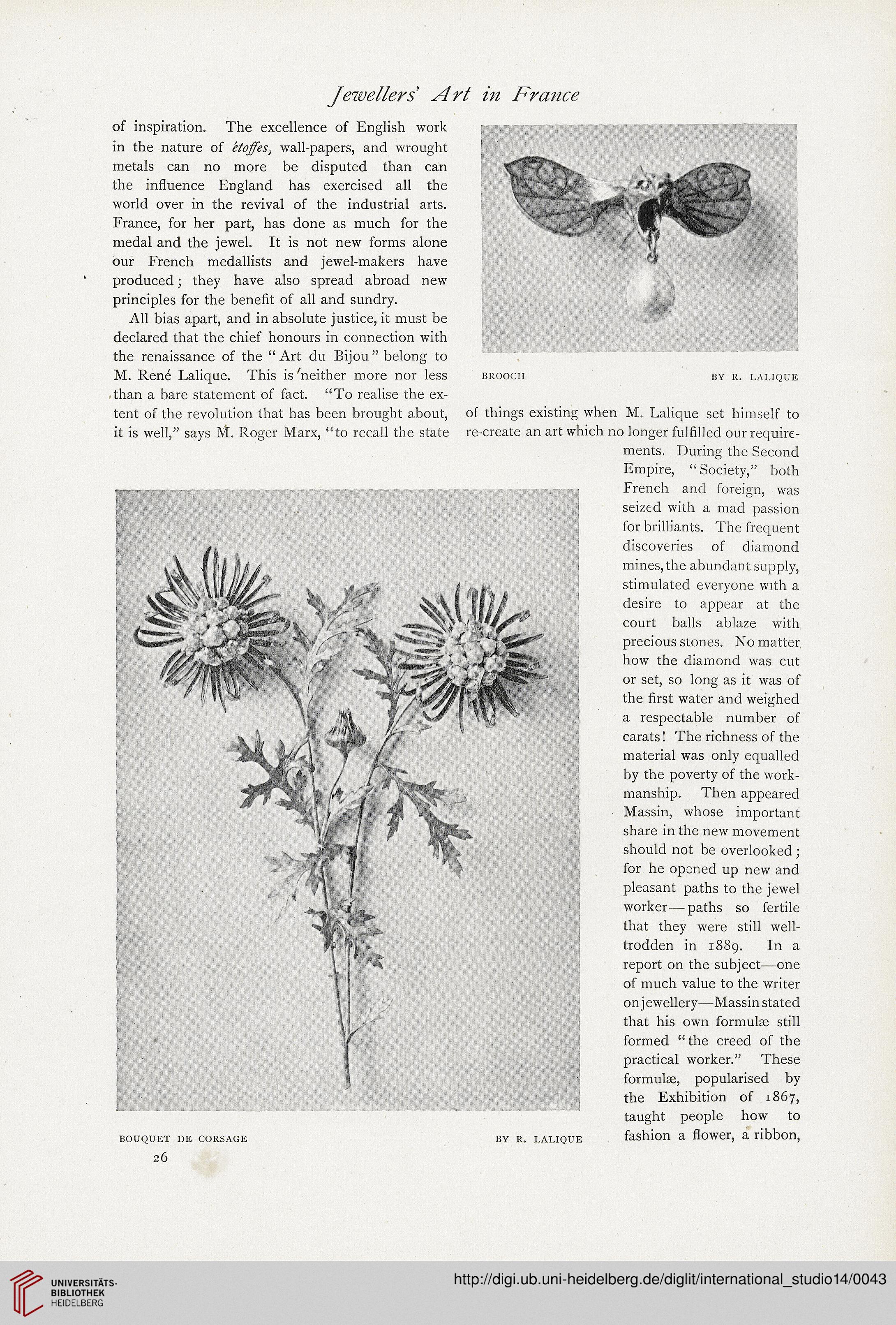Jewellers Art in France
BROOCH
BY R. LALIQUE
of inspiration. The excellence of English work
in the nature of ktoffes, wall-papers, and wrought
metals can no more be disputed than can
the influence England has exercised all the
world over in the revival of the industrial arts.
France, for her part, has done as much for the
medal and the jewel. It is not new forms alone
our French medallists and jewel-makers have
produced; they have also spread abroad new
principles for the benefit of all and sundry.
All bias apart, and in absolute justice, it must be
declared that the chief honours in connection with
the renaissance of the “ Art du Bijou ” belong to
M. Rene Lalique. This is 'neither more nor less
.than a bare statement of fact. “To realise the ex-
tent of the revolution that has been brought about,
it is well,” says ±\1. Roger Marx, “to recall the state
of things existing when M. Lalique set himself to
re-create an art which no longer fulfilled our require-
ments. During the Second
Empire, “Society,” both
French and foreign, was
seized with a mad passion
for brilliants. The frequent
discoveries of diamond
mines, the abundant supply,
stimulated everyone with a
desire to appear at the
court balls ablaze with
precious stones. No matter
how the diamond was cut
or set, so long as it was of
the first water and weighed
a respectable number of
carats! The richness of the
material was only equalled
by the poverty of the work-
manship. Then appeared
Massin, whose important
share in the new movement
should not be overlooked;
for he opened up new and
pleasant paths to the jewel
worker— paths so fertile
that they were still well-
trodden in 1889. In a
report on the subject—one
of much value to the writer
on jewellery—Massin stated
that his own formulae still
formed “the creed of the
practical worker.” These
formulae, popularised by
the Exhibition of 1867,
taught people how to
fashion a flower, a ribbon,
BOUQUET DE CORSAGE
BY R. LALIQUE
26
BROOCH
BY R. LALIQUE
of inspiration. The excellence of English work
in the nature of ktoffes, wall-papers, and wrought
metals can no more be disputed than can
the influence England has exercised all the
world over in the revival of the industrial arts.
France, for her part, has done as much for the
medal and the jewel. It is not new forms alone
our French medallists and jewel-makers have
produced; they have also spread abroad new
principles for the benefit of all and sundry.
All bias apart, and in absolute justice, it must be
declared that the chief honours in connection with
the renaissance of the “ Art du Bijou ” belong to
M. Rene Lalique. This is 'neither more nor less
.than a bare statement of fact. “To realise the ex-
tent of the revolution that has been brought about,
it is well,” says ±\1. Roger Marx, “to recall the state
of things existing when M. Lalique set himself to
re-create an art which no longer fulfilled our require-
ments. During the Second
Empire, “Society,” both
French and foreign, was
seized with a mad passion
for brilliants. The frequent
discoveries of diamond
mines, the abundant supply,
stimulated everyone with a
desire to appear at the
court balls ablaze with
precious stones. No matter
how the diamond was cut
or set, so long as it was of
the first water and weighed
a respectable number of
carats! The richness of the
material was only equalled
by the poverty of the work-
manship. Then appeared
Massin, whose important
share in the new movement
should not be overlooked;
for he opened up new and
pleasant paths to the jewel
worker— paths so fertile
that they were still well-
trodden in 1889. In a
report on the subject—one
of much value to the writer
on jewellery—Massin stated
that his own formulae still
formed “the creed of the
practical worker.” These
formulae, popularised by
the Exhibition of 1867,
taught people how to
fashion a flower, a ribbon,
BOUQUET DE CORSAGE
BY R. LALIQUE
26




